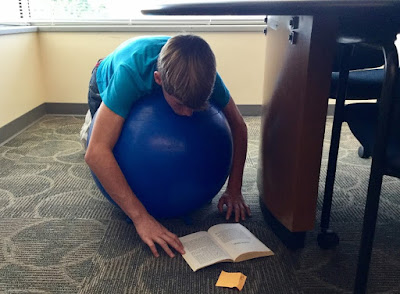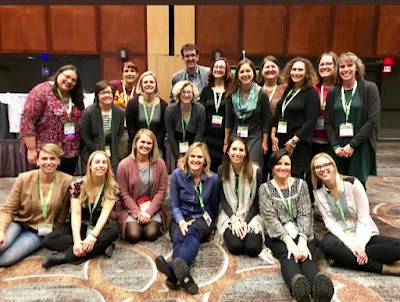Uncovering the I in our high school classrooms
Walk into my classroom during the first twenty minutes each day and I love what you’ll see. Students are sprawled around the room reading, some in desks, some on shaggy carpets, and even one on his stomach draped over an exercise ball. It’s quiet except for pages turning and me wandering around with my notebook, or sometimes not. Because I believe strongly in choice, independent reading and in having a classroom library plentifully stocked with books that real kids want to read, reading time is beautiful at this point in the year. Our end of the semester celebration letters left me smiling with the number of pages read, the favorite books found, the authors my students want to meet.
Despite all of this good, there is more work to do. Always, right?
For close to fifteen years, I taught a middle school language arts class and worked hard to integrate choice reading and writing. Students were always reading an independent book, and were always writing about their own topics in their Writer’s Notebooks. To me, each was an essential part of our class, a way to always be reading and writing, no matter what our class instructional focus was at the time.
Then I moved to high school and after a year, slid into the role of Reading Specialist. Not Literacy Coach, but Reading Specialist. Just reading. For the last 3 ½ years. But that missing piece of writing keeps whispering to me, like a secret I’ve locked in the attic. It wants to come out.
Honestly, I think when I looked at my students’ sometimes overwhelming needs with reading, it was easy to ignore writing. We really just need to focus on reading, I’d think. Really.
So, our writing has been limited to responses to books. After reading Kylene Beers and Bob Probst’s Disrupting Thinking this summer, I adopted the book, head, heart framework to help my students talk about not only what was in their books and what they were thinking about, but also to move them into what they were feeling -- how the book was impacting and changing them.
This proved challenging to my students, who clung to the safety of the book. They wanted to tell me what the characters were feeling instead of what they were feeling, as if they had been so conditioned already by academic writing and the dismissal of the I that they couldn’t believe that a teacher really wanted to know their actual feelings.
But I do.
I want my students to know that their I matters, that their education is not just about being a sponge and taking in others’ ideas and wringing them out into a bucket of dirty water they collect over the years. I want them to know that their thoughts, feelings, wonderings, musings, and just plain old babbling, matters.
My beliefs began colliding sharply with the reality of my classroom this fall. For a teacher who puts so much emphasis on voluminous, pleasurable, choice reading, why can’t I create the same space for voluminous, pleasurable, choice writing? In my own life, I cannot imagine only reading, reading, reading. I need my journal, my sacred writing space to dump and sort all the thinking in my brain. I call it my pensieve and it keeps me sane. Why have I not shared this with students when I believe in it so deeply?
This is why I love January. It’s a new start with the same group of kids. We have some history, some well-established structures, some groundwork to build upon as we enter this new semester. It’s time to open the attic door and let writing out.
But not just any writing.
All the self-selected reading in my classroom must be balanced with self-selected writing. My students need a space to air what's on their minds, what's in their hearts. What stories do they want to tell, and how do they want to tell them? It’s like we’ve been breathing in for a whole semester, taking in the ideas of others. Now it's time to exhale, to share our own stories and ideas. We can only build truly literate lives when we value both processes equally.
I suspect that this imbalance is a big part of the reason many of my students have fallen short of becoming readers outside our cozy classroom world. I opened the door to choice and they love hanging out for a while, visiting authors who write books they love, wandering around in the pages, reading words that touch their hearts.
They just don't see themselves as part of the literary club these author belong to. There is no urgency to stay in this world of books, just like there is no urgency to create after visiting a museum if you don't see yourself as an artist. You quietly, respectfully admire the work of others (or pretend if that's what you think you're supposed to do) and then you go home. But what if someone taught you to notice the craft of these artists, gave you some tips on how to get started, and then provided time, supplies, and consistent, encouraging coaching with the only expectation that you enjoy yourself and paint what you want? You might now visit museums with different eyes. You might eventually come to see yourself as someone who could mimic, learn, and even create.
If teachers want students who actually grow into fully literate human beings, we must extend choice to the world of writing. I do not mean, "Here are three ways to respond to this piece of text. Now pick one." I mean real choice. Our Writer's Notebooks must be reclaimed as idea grounds, places to explore what matters most to our students. We must allow our students time to notice life around them, to get close, to look with curiosity at the people, the places, the actions that make up their own lives. And then they must be given consistent, copious amounts of time (just like I do with reading) to relax and write. Write drivel. Write garbage. Shoot, write total and complete crap. But write what matters most to you.
Before I jump into the twelve other topics that are swirling around in my head about writing, I'm going to stop right here. In my excitement, I can easily come up with an entire semester's worth of changes that I must make in my classroom. RIGHT. NOW. So, I’m putting the brakes on, letting myself just swim with this idea for a while.
One change: every day I will give my students the gift of independent writing time, just like I do with reading. And, just like with reading at the beginning of the semester, I know they will need to be eased into it, to have support, models, and encouragement. I accept that it will take just as long to create a daily habit of writing (maybe even longer) as it did to create a daily habit of reading. And there will be bumps and resistance and growth and ah-ha moments.
I also expect that if you peek inside our classroom in May, you might still catch us quietly lost in the worlds of our books, or you might see something different. Maybe a whole new world will have emerged, one where my students see themselves in an entirely different light: one where their own words matter just as much as the ones on the pages they read.






Comments
Post a Comment